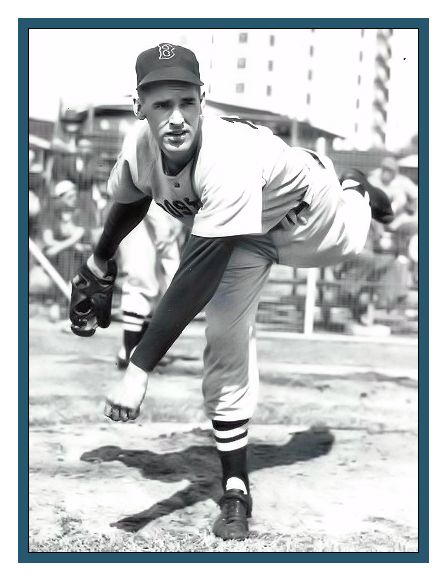|
“FENWAY'S BEST PLAYERS”  |
|||||
The term hero is thrown around when we talk about our sports stars. However, among all the major league ballplayers who served in World War II, the story of Earl Johnson is one of a true military hero. After pitching a little semipro ball in 1939, the Red Sox signed Earl for the 1940 season. Though still 21 years old, he got a quick promotion to the major league ballclub. In August 1940, he threw his first shutout, scattering eight hits against Washington and only two Senators had reached third base. The next season, after he began to hit his stride once more and was pitching well, he came down with a sore arm. Little did Earl know that he would miss the next four full seasons to serve in the United States Army during World War II. He was inducted in January 1942, and unlike most ballplayers, after going through training, he saw combat duty. Sgt. Earl Johnson served with the 120th infantry (30th Division) and landed in Europe, 21 days after D-Day and had to go through Omaha Beach. He was a rifle platoon sergeant, involved in liberating many towns in France and Belgium and he fought in five major conflicts. In September 1944, while receiving hostile fire, an allied truck was struck by an enemy shell and had to be abandoned. It contained vital radio equipment and had to be recovered before falling into enemy hands. Sergeant Johnson and several other members of his unit braved hostile fire and were completely successful in dragging the vehicle over to a safe area in plain view of the enemy. In another battle, he also helped an American tank crew drive through a minefield, on its way to wiping out a German position that had pinned down his men. While in France, he and his men were fighting hedgerow by hedgerow when they noticed a Nazi panzer lying in ambush for his platoon. He and another one of his men snuck up and tossed grenades into the tank, killing all five of the Germans inside. Johnson and his platoon went on to bravely fight in the Battle of the Bulge. They started with 36 men but ended with only 11. For heroism in combat, Earl Johnson was awarded the Bronze Star, a Bronze Star with clusters, and the Silver Star. He also received a battlefield commission promoting him to lieutenant. With the war over in 1945, Lt. Johnson was demobilized and joined many other Red Sox veterans coming back to play baseball. He’d missed four full years, more than anyone else on the Red Sox, and unlike many others, he’d not been playing service baseball and had never touched a ball the whole time. Though he started five games in 1946, he was primarily used in relief and all five of his wins came as a reliever. During the World Series against the Cardinals, Earl pitched a hitless ninth and tenth innings in Game #1 and got the win. Earl went on to have his best year in 1947. His first start of ’47 came in early July, against the Tigers, shutting them out, 2-0, on six hits, while he went 3-for-3 at the plate. His next start came later in July, and in the bottom of the first inning, after he surrendered three consecutive singles that loaded the bases, with nobody out, he got out of the jam and never allowed another hit for the rest of the game. The final was 1-0, Red Sox. He was involved in three more 1-0 games in 1947 and started every one of them. From 1948 thru 1950, Earl was used almost exclusively in relief. In July 1950, he was given his outright release. Tom Yawkey however, kept him on the Red Sox roster for 12 more days so that he would become a 10-year man and thus be eligible to collect his pension. Earl worked as a Red Sox scout in 1953 and served as a full-time West Coast scout until he retired following the 1985 season. He suffered a minor stroke in the early 1990s and died in Seattle on December 3, 1994, at age 75.
|
|||||

